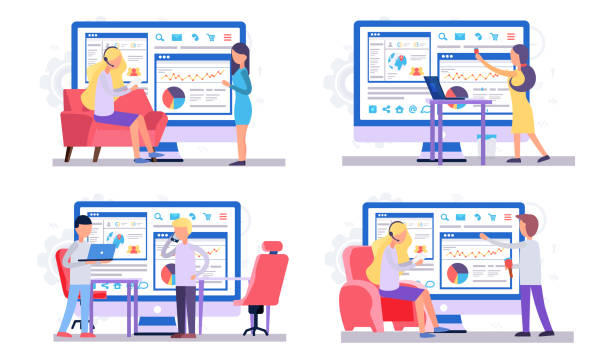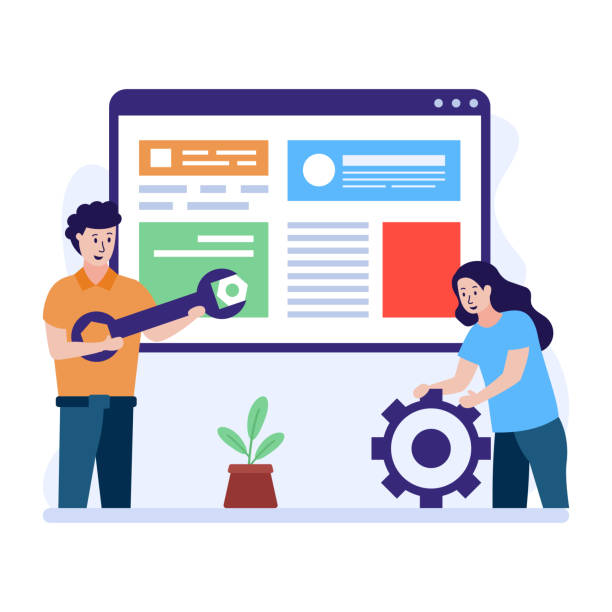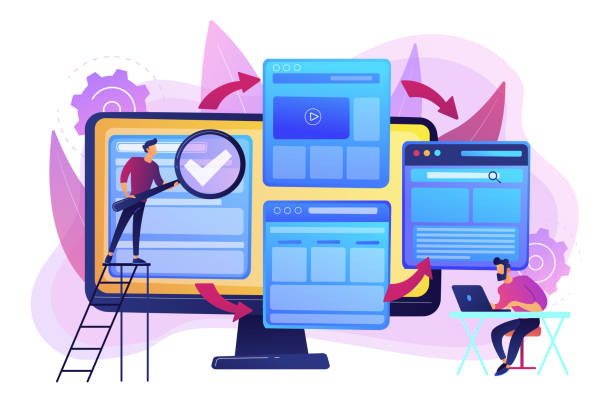The Importance of Speed in Today’s Web World

In today’s digital age, the #speed of your website’s loading is not just a competitive advantage but a necessity for online survival and success.
Today’s users are more impatient than ever and expect web pages to load in a fraction of a second.
Any small delay can mean losing visitors, reducing conversion rates, and harming your brand’s credibility.
From an SEO perspective, search engines like Google consider site speed as a crucial ranking factor.
A slow website will seriously lower your rank in search results and limit access for potential audiences.
The goal of fast website design is not only to reduce page loading time but also to improve overall user experience (UX) and ensure quick and easy access to content.
This is an explanatory and analytical discussion on why investing in website speed optimization is of vital importance.
Does your current site showcase your brand’s credibility as it should? Or does it drive potential customers away?
Rasaweb, with years of experience in professional corporate website design, is your comprehensive solution.
✅ A modern, beautiful website tailored to your brand identity
✅ Significant increase in lead and new customer acquisition
⚡ Contact Rasaweb now for a free consultation on corporate website design!
Key Factors Affecting Fast Website Design

To achieve fast website design, understanding the factors influencing loading speed is essential.
These factors vary across different aspects, from technical infrastructure to coding methods and content optimization.
The first and most important factor is hosting.
Choosing a powerful and optimized hosting service that uses high-speed and stable servers is the cornerstone of your website’s speed.
Server resources, database type, and bandwidth all play a significant role.
Second, the size and number of website files.
Large and unoptimized images, bulky CSS and JavaScript files, and numerous fonts can severely reduce loading speed.
Optimizing images before uploading and compressing codes are key actions.
Third, the quality of coding and the use of lightweight and efficient frameworks.
Excess code, render-blocking scripts, and numerous HTTP requests can all create bottlenecks.
This specialized and educational section helps you gain a deeper understanding of the challenges and opportunities available for increasing site load speed.
Understanding these factors is crucial for any effort in fast website design.
Tools and Techniques for Measuring and Optimizing Speed

To achieve fast website design, you must first assess your current website speed.
There are numerous tools for this purpose, each providing valuable information and analysis.
Google PageSpeed Insights, GTmetrix, and Pingdom Tools are among the most famous.
These tools not only provide a score for your site’s speed but also offer a list of existing problems and suggested solutions.
For example, they might recommend compressing images, optimizing CSS and JavaScript, or enabling caching.
After identifying problems, it’s time to apply optimization techniques.
These techniques include Gzip compression for server files, using responsive images and lazy loading for delayed image loading, reducing HTTP requests, and removing render-blocking resources.
This section provides a comprehensive guide and explanation for implementing these optimizations.
The table below compares some popular tools:
| Tool Name | Key Features | Main Focus |
|---|---|---|
| Google PageSpeed Insights | Performance score (Core Web Vitals), optimization recommendations, mobile and desktop user experience | Alignment with Google’s SEO metrics |
| GTmetrix | YSlow and PageSpeed scores, Waterfall Chart, performance history | Deep analysis of resource loading |
| Pingdom Tools | Test from different locations, Waterfall Chart, overall loading time | Ease of use and testing speed |
The Impact of Speed on SEO and User Experience

As mentioned earlier, fast website design has a direct impact on SEO and user experience (UX).
From an SEO perspective, Google has explicitly stated that page speed is a ranking factor, especially with the introduction of Core Web Vitals, which provide specific metrics for evaluating user experience.
Slower websites have a higher bounce rate, meaning users quickly leave the site, which is a negative signal for search engines.
In contrast, a fast-loading website encourages users to stay longer, view more pages, and interact more.
This improvement in user experience indirectly sends positive signals to search engines and helps increase rankings.
From an analytical perspective, numerous studies have shown that every second of loading delay can lead to a significant reduction in conversions and revenue, especially for e-commerce websites.
This topic not only includes technical optimization but also provides an educational perspective on the importance of speed in the overall digital marketing strategy.
Are you frustrated with your online store’s low conversion rate?
Rasaweb, with professional e-commerce website design, is your definitive solution!
✅ Increase your sales and revenue
✅ Unparalleled user experience for your customers
⚡ Get a free consultation now!
Server-Side Optimization for High Performance

A vital part of fast website design is server-side performance optimization.
These actions often happen behind the scenes but have a significant impact on response time and overall site loading.
The first step is choosing a powerful server and configuring it correctly.
Using SSD servers, increasing RAM, and using more powerful processors can make a significant difference.
Second, database optimization.
Efficient queries, proper table indexing, and periodic cleaning of unnecessary information from the database all help reduce server response time.
Using Content Management Systems (CMS) like WordPress requires more database optimization.
Third, enabling Gzip or Brotli compression, which allows the server to compress files before sending them to the browser, significantly reducing the volume of data transferred.
Fourth, using newer versions of HTTP protocols like HTTP/2 or HTTP/3, which support Multiplexing and header compression, drastically improve the communication speed between the server and the client.
This specialized and comprehensive guide ensures that your backend infrastructure is ready for a high-speed website.
Front-End Optimization Strategies

After server-side optimization, it’s time for front-end optimization strategies, which directly engage with the user experience and constitute a significant part of the fast website design process.
One of the most important measures is Minification of CSS, JavaScript, and HTML files.
This process involves removing white spaces, comments, and unnecessary characters from the code, which reduces file sizes and accelerates loading time.
Second, image optimization.
Images often make up the largest part of a web page.
Using appropriate image formats (such as WebP), compressing images without significant quality loss, and implementing Lazy Loading for images not in the user’s view during initial page load are essential.
Third, reducing the number of HTTP requests.
Every CSS, JavaScript file, or image that loads creates a separate HTTP request.
Combining files, using image Sprites, and optimizing fonts can reduce the number of these requests.
Fourth, optimizing fonts and using the Font-Display: Swap property to prevent invisible content while fonts are loading.
This is an explanatory and educational section that ensures your user interface loads quickly and provides an optimal user experience.
The Role of Content Delivery Networks (CDN) and Caching

In the context of fast website design, Content Delivery Networks (CDN) and caching play a very crucial role.
A CDN is a system of distributed servers across different parts of the world that store cached versions of your website’s static content (such as images, CSS, JavaScript).
When a user accesses your website, the CDN delivers the content from the server closest to them, which significantly reduces loading time, especially for international users.
Caching is also a process where copies of your website’s content are temporarily stored, so they don’t need to be reloaded from the main server on every visit.
Caching can be done at various levels:
- Browser Caching: The user’s browser stores static files.
- Server-side Caching: The server caches pages or database results.
- CDN Caching: As explained, the CDN stores content on its edge servers.
These techniques complement each other and collectively contribute significantly to increasing site load speed.
This is a specialized and analytical section that can transform your website’s performance.
The table below shows the types of caching:
| Caching Type | Storage Location | Main Application |
|---|---|---|
| Browser Caching | User’s browser | Reduces loading time for repeated visits |
| Server-side Caching | Website server | Reduces server load and accelerates dynamic page generation |
| CDN Caching | Distributed CDN servers | Serves content from the closest point to the user |
| Object Caching | Server RAM or file system | Stores database query results and complex calculations |
Fast and Responsive Website Design for Mobile

With the increasing use of mobile devices to access the internet, fast and responsive website design for mobile has become vitally important.
Google has also doubled its emphasis on mobile user experience with the introduction of mobile-first indexing.
A website that loads quickly on a desktop will not necessarily be fast on mobile, as mobile devices have their own bandwidth and processing power limitations.
Therefore, specific approaches are needed for building high-speed websites on mobile.
This includes true responsive design that not only adapts the layout but also optimizes resources.
Using responsive images with different sizes for various devices, optimizing fonts for mobile, and removing unnecessary scripts for mobile display are among the key actions.
Additionally, technologies like AMP (Accelerated Mobile Pages) can help with extremely fast page loading on mobile, although they might have some design limitations.
This section provides a guide and news on the latest developments and the importance of this topic in today’s world.
Does your current website convert visitors into customers or drive them away? Solve this problem forever with professional corporate website design by Rasaweb!
✅ Build credibility and powerful branding
✅ Attract target customers and increase sales
⚡ Get a free consultation now!
Continuous Maintenance and Monitoring of Site Speed

The process of fast website design is not a one-time project but requires continuous maintenance and monitoring.
After implementing initial optimizations, website speed can decrease due to the addition of new content, plugins, or external scripts, or changes to the server.
Therefore, it is necessary to regularly monitor your website’s speed.
Tools like Google PageSpeed Insights, GTmetrix, or even server monitoring solutions like New Relic, can help you identify speed drops and potential issues.
Setting up automatic alerts for when site speed drops below a certain threshold is an excellent preventive measure.
Furthermore, regular optimization and updates of plugins and themes (if using a CMS), periodic database cleaning, and ensuring new uploaded images are optimized are key maintenance actions.
This is an educational and thought-provoking content that shows why a one-time optimization is not enough for an agile website and requires a continuous approach.
The Future of Fast Website Design and New Trends

The future of fast website design lies in emerging technologies and new trends in web development.
One of the most important is the emergence of Progressive Web Apps (PWAs), which combine the best features of web and mobile applications.
PWAs can work offline, send notifications, and provide an app-like user experience with high speed.
Another trend is optimization for Google’s Core Web Vitals, which set precise criteria for website speed and interactivity, pushing developers toward creating unparalleled user experiences.
The advent of newer protocols like HTTP/3, built on QUIC, promises faster and more stable communications in the future.
Furthermore, the use of artificial intelligence for automatic optimization of images, codes, and even caching is also under development.
This entertaining and analytical section looks at new horizons in high-performance web development and shows how we can prepare for the next generation of fast website design.
Frequently Asked Questions
| No. | Question | Answer |
|---|---|---|
| 1 | What does fast website design mean? | Optimizing a website for fast page loading, improving user experience and SEO ranking. |
| 2 | Why is site loading speed important? | Increases user satisfaction, reduces bounce rate, improves SEO, and increases conversion rates (sales/actions). |
| 3 | What tools are available for testing site speed? | Google PageSpeed Insights, GTmetrix, Pingdom Tools are common tools. |
| 4 | What are the main factors causing a slow website? | Unoptimized images, heavy JavaScript and CSS codes, poor hosting, and lack of caching. |
| 5 | “Caching” (Caching) what is it and how does it help site speed? | Temporary storage of site data in the user’s browser or server for faster loading on subsequent visits. |
| 6 | How to optimize images to increase site speed? | Reduce image size (compression) without significant quality loss, use modern formats (WebP), and set appropriate dimensions. |
| 7 | What role does CDN (Content Delivery Network) play in fast website design? | Distributes website content across various servers worldwide to deliver content from the closest server to the user. |
| 8 | Does choosing suitable hosting affect site speed? | Yes, quality hosting and powerful servers are essential for fast site loading. |
| 9 | What is Minification technique and why is it used? | Removing extra characters (white spaces, comments) from HTML, CSS, JavaScript codes to reduce file size. |
| 10 | What is the relationship between responsive design and site speed? | Responsive design means correct display on different devices; if not implemented correctly, it can create extra load and reduce speed. Responsive optimization is crucial for speed. |
And other services of Rasaweb Advertising Agency in the field of advertising
How advertorials help manufacturers in global competition
Techniques for writing attractive headlines for office machine advertorials
How advertorials help introduce after-sales services
The role of advertorials in creating emotional connections with customers
How to stand out from competitors on classified ad websites with advertorials
And more than a hundred other services in the field of internet advertising, advertising consultation, and organizational solutions
Internet Advertising | Advertising Strategy | Advertorial
🚀 For your business to leap forward in the digital world and experience unparalleled growth, Rasaweb Afarin is your smart companion. With our expertise in SEO, content marketing, and especially user-friendly website design, you will have a powerful and lasting presence on the web.
📍 Tehran, Mirdamad Street, next to Bank Markazi, Kazeroon Janoubi Alley, Ramin Alley, No. 6


